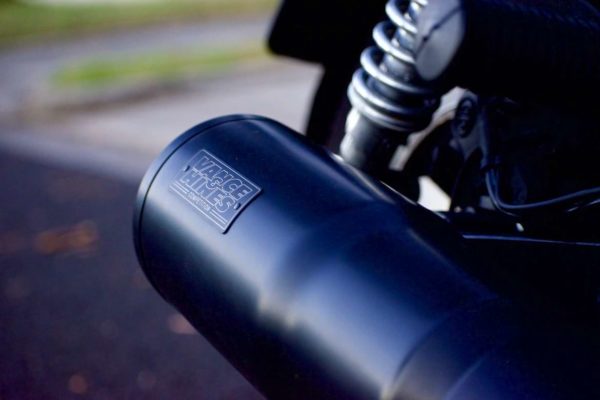Indeed, air pollution is the primary concern we riders should focus on most. Now, do you need a catalytic converter on a motorcycle?
According to the EPA, motorbikes in the US also have to follow strict guidelines to reduce greenhouse gas emissions. However, they didn’t mention installing the catalytic converter on the motorcycle to reduce the greenhouse gas emission rate, still, you should install it to protect the environment from harmful greenhouse gasses.
Let’s consider what it means and what you can do about it.
While writing this post, I leave no stone unturned so you can know everything about the need for a catalytic converter on a motorcycle.
Table of Contents
Do You Need a Catalytic Converter on a Motorcycle?
Pollution is the main reason behind the greenhouse effect and melting glaciers, and some recommend installing catalytic converters to reduce greenhouse gas emissions. Now, do you need a catalytic converter on a motorcycle?
According to the EPA, motorbikes in the US also have to follow strict guidelines to reduce greenhouse gas emissions. However, they didn’t mention installing the catalytic converter on the motorcycle. Still, you should install it to protect the environment from harmful greenhouse gasses.
With the catalytic converter, you can rest assured that your motorbike won’t produce harmful gasses, including carbon monoxide.
Is Installing the Catalytic Converter Good?
So far, you understand that there’s no need but optional to install the catalytic converter. Now the question arises, is installing the catalytic converter suitable?
Installing the catalytic converter is one of the best things you can do with your motorbike, as the converter can reduce greenhouse gas emissions significantly. With the catalytic converter, you can be assured that your motorbike won’t cause any serious concern to the environment.
And that’s why experts recommend installing the catalytic converter to become an environmentally friendly motorbike rider.
What if You Don’t Install a Catalytic Converter on a Motorcycle?
Indeed installing a catalytic converter is suitable for nature; what if you don’t install a catalytic converter?
Suppose you don’t install the catalytic converter on your motorbike, then your motorbike will emit too many greenhouse gasses, including CO and N2O (nitrous oxide). These gasses will fail your motorbike at the pollution test, causing you to pay an extra fine for pollution.
Not only this, but in some cases, your motorbike engine will sound strange because of the absence of a catalytic converter.
Also, don’t forget to read my previous post where I discussed some reasons why the electric motorbikes are great in terms of no pollution mechanism and which motorbike would be best for you, CLICK HERE to read.
How do Catalytic Converters Work?
So far, you understand why new motorbikes have catalytic converters and not old motorcycles. But have you wondered how catalytic converters work?
Catalytic converters follow the principle of catalysis, which involves converting harmful unburned gasses caused by incomplete combustion to burned and less toxic gasses. Catalytic converters mainly focus on carbon monoxide and nitrous oxide gasses to form carbon dioxide and less harmful gasses.
To understand how the converters work, you should first know some gasses released in the combustion.
In the ideal condition, the combustion in your motorbike engine releases carbon dioxide (CO2), and water (H2O) with some extent of Nitrogen and Hydrogen.
These glasses are less harmful to the environment and don’t contribute much to the greenhouse effect.
In a real-life situation, the case is not so ideal.
Because of a lack of air and sometimes low fuel quality, your motorbike suffers from incomplete combustion, releasing harmful gasses like carbon monoxide (CO) and nitrous oxide (NO).
These glasses are relatively harmful to our environment and cause a greenhouse effect causing our glaciers to melt.
And here, the catalytic converter comes into play.
Catalytic converters have catalysts in them which add lost H (hydrogen atom) in CO (carbon monoxide) to form CO2 (carbon dioxide).
This same principle applies to all other gasses; catalytic converters add oxygen molecules to make glasses less harmful.
Because of the nature of catalytic converters to convert greenhouse gasses to less harmful gasses, people call the whole system a catalytic converter.
What do Catalytic Converters contain?
So far, you understand motorcycle catalytic converters and how they work. Now the question is, what do catalytic converters contain?
Catalytic converts mainly contain two parts; the first is ceramic, and the second is rare elements that perform catalysis. Although ceramic doesn’t perform any activity, it gives the heating environment crucial for catalytic converters to perform well. While rare elements act as reduction catalysts.
The catalysis converters have two working parts, which are crucial for any converter to work fine.
The most significant disadvantage of a catalytic converter is that it can’t perform in cold conditions. And to tackle this problem, manufacturers are starting to fit ceramic, making the converter temperature high.
Ceramics don’t do anything but facilitate the ideal environment (high temperature) to work fine.
On the other hand, rare metals such as Palladium, Platinum, and Rhodium act as catalysis agents responsible for changing harmful gasses to less dangerous gasses.
I’ve mentioned the proper working of the converter above.
For a better understanding, see the below YouTube video:
Can you Install Catalytic Converters?
So far, you understand how convertors and converters work, but the problem is old motorbikes don’t contain catalytic converters.
To save the environment, one can install catalytic converters on their motorbike separately. But it’s a bit tech and may require specialization, so experts always recommend hiring a technician to do this work. Additionally, always install converters that are made for your motorbike.
Also, don’t forget to check the fuel and exhaust tube when installing converters, as a blockage may cause incomplete combustion.
How Much Does it Cost to Install Catalytic Converters?
Now you know you can install catalytic converters on your old motorbike too? Now the question arises, how much will it cost?
On average, the motorbike catalytic converter will cost you around $100. However, this average will vary from location to location. For example, in Washington, it will cost you more than the average price, while in West Virginia, it will cost you less. Also, converters with rare metals will be more expensive.
The above-average price of a catalytic converter doesn’t include technician costs.
Is it Illegal to Remove Catalytic Converters?
We all want to protect ourselves from fines and penalties, and when it’s about our motorbike, we’ve to be more conscious.
Currently, there’s no law regarding catalytic converters in the USA. While in some European countries, you’ve to pay some penalties if your motorbike exhaust doesn’t have catalytic converters. But this doesn’t mean you shouldn’t install catalyst converters on your motorbike.
Don’t forget to start small to save the environment.
Do Catalytic Converters Really Work?
There’s an entirely new trend in the market for installing catalytic converters into your motorbike. But does the catalyst really work? Or it’s just another hype.
Catalytic converters reduce greenhouse gas emissions from your motorbike, thus saving the environment. But catalytic converters need around 600F to work correctly. It means converters won’t work until your motorbike reaches 600F. For the first 30 minutes, your motorbike converter won’t convert greenhouse gasses to clean gas.
It’s the most significant disadvantage of converters, so it’s recommended to leave your motorbike starting for around 15 minutes.
Simply put, your motorbike converters won’t work if you ride a short ride.
You can read the book “Air Pollution from motor vehicles.” Click here to read for a better understanding; you can see table 3.2 on page number 75.
Frequently Asked Questions:
Is installing the catalytic converter good?
Installing the catalytic converter is one of the best things you can do with your motorbike, as the converter can reduce greenhouse gas emissions significantly. With the catalytic converter, you can be assured that your motorbike won’t cause any serious concern to the environment.
What if you don’t install a catalytic converter on a motorcycle?
Suppose you don’t install the catalytic converter on your motorbike. In that case, the motorbike will emit many greenhouse gasses, including CO and N2O (nitrous oxide). These gasses will fill your motorbike at the pollution test, causing you to pay an extra fine for pollution.
How do catalytic converters work?
Catalytic converters follow the principle of catalysis, which involves converting harmful unburned gasses caused by incomplete combustion to burned and less toxic gasses. Catalytic converters mainly focus on carbon monoxide and nitrous oxide gasses to form carbon dioxide and less harmful gasses.
What do catalytic converters contain?
Catalytic converts mainly contain two parts; the first is ceramic, and the second is rare elements that perform catalysis. Although ceramic doesn’t perform any activity, it gives the heating environment crucial for catalytic converters to perform well. While rare elements act as reduction catalysts.
Can you install catalytic converters?
To save the environment, one can install catalytic converters on their motorbike separately. But it’s a bit tech and may require specialization, so experts always recommend hiring a technician to do this work. Additionally, always install converters that are made for your motorbike.
Final Verdict:
Do you need a catalytic converter on a motorcycle? According to the EPA, motorbikes in the US also have to follow strict guidelines to reduce greenhouse gas emissions. However, they didn’t mention installing the catalytic converter on the motorcycle. Still, you should install it to protect the environment from harmful greenhouse gasses.
I’ve also mentioned the approximate cost of installing the catalytic converter, which can vary according to your area and the motorbike model you own.
John, this side! My passion for motorbikes started when I was 12. I experienced many accidents and even lost some friends too. And it inspired me to create this website so that no parents in this world would lose their child while enjoying riding.


